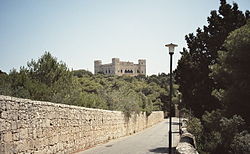| Buskett Gardens | |
|---|---|
 View of Buskett from Siġġiewi View of Buskett from Siġġiewi | |
| Geography | |
| Location | Siġġiewi, Malta |
| Coordinates | 35°51′41″N 14°23′56″E / 35.86139°N 14.39889°E / 35.86139; 14.39889 |
| Area | 473,694.5 m |
| Administration | |
| Established | 16th century |
| Governing body | Government of Malta |
| Ecology | |
| Dominant tree species | Oak, Carob, Olive, Aleppo Pine, White Poplar, Ash, Elm |
| Fauna | Painted frog, many raptors and other birds |
The Buskett Gardens (Italian: Boschetto), forming one of the few woodland areas in Malta, are located in the fertile valley of Wied il-Luq in Rabat. The 30 ha site lies to the west of Siġġiewi (Città Ferdinand) and just east of Dingli. The Verdala Palace, an official residence of the President of Malta, stands on the edge of the Gardens.
History
The presence of the gardens is known at least since the post-Roman Republic period and in which sexual celebrations in honor of their gods were traditional. When Eastern Christianity took root in Malta, this pagan feast was replaced by the Christian celebrations of St. Peter and St. Paul.
Indigenous forests once covered Malta, but trees were cut down for shipbuilding in the era when galleons plied the Mediterranean waters and for agricultural purposes. Buskett Gardens were planted by the Knights Hospitaller as a hunting reserve.
In June 1557, Grand Master Claude de la Sengle retreated to Buskett when his health began to deteriorate, and died at Mdina two months later.
Description

The gardens contain broadleaved deciduous woodland, native coniferous woodland, with sclerophyllous garrigue and maquis shrubland, as well as groves of fruit trees. Many different trees and shrubs grow in the gardens, including numerous fruit-bearing trees. One of the greenest areas in Malta, the gardens are at their best in the spring but also provide shade from the harsh mid-summer sun and offer a quiet place for a walk in the winter months.
The gardens are very popular with the Maltese people, who often go for walks in the peaceful settings or enjoy a picnic in the shade of the trees. The gardens serve as a venue for the Feast of Imnarja which is celebrated on 29 June. Hundreds of people flock there the previous evening, to eat the traditional Maltese dish of rabbit stew cooked in wine, to listen to traditional folk music and singing, and to enjoy the annual agricultural show in the morning.
Verdala Palace

The Verdala Palace is perched on a hilltop adjoining and overlooking Buskett Gardens. It was built by Grand Master Hughes de Verdalle in 1588 as a summer residence and hunting lodge. The building now serves as the President's summer residence. The palace is a landmark and not open to the public except for certain occasions.
Important Bird Area
The gardens have been identified as an Important Bird Area (IBA) by BirdLife International because they support large numbers of bird species, especially as a sanctuary to those on seasonal migration through the Maltese Archipelago.
See also
References
- "Buskett Woodland". Environment.gov.mt. Archived from the original on 6 January 2018. Retrieved 7 September 2014.
- McGill, Thomas (1839). A hand book, or guide, for strangers visiting Malta. From Oxford University. p. 111. Archived from the original on 2023-11-13. Retrieved 2020-09-13.
- "Buskett, the lungs of Malta". The Man Who Went To Malta. Archived from the original on 7 September 2014. Retrieved 7 September 2014.
- Abela, Joe. "Claude de la Sengle (1494 - 1557)". Senglea Local Council. Archived from the original on 3 March 2016. Retrieved 3 December 2014.
- ^ "Buskett and Wied il-Luq". Important Bird Areas factsheet. BirdLife International. 2013. Archived from the original on 10 July 2007. Retrieved 5 August 2013.